Jump to the Recipe
Au jus is an easy-to-make reduction sauce that combines the drippings from the meat plus additional stock. Pronounced “oh zhoo,” it’s a french word that means “with juice.” In its simplest form, it’s basically stock that has been boiled down or “reduced” to give it a stronger flavor.
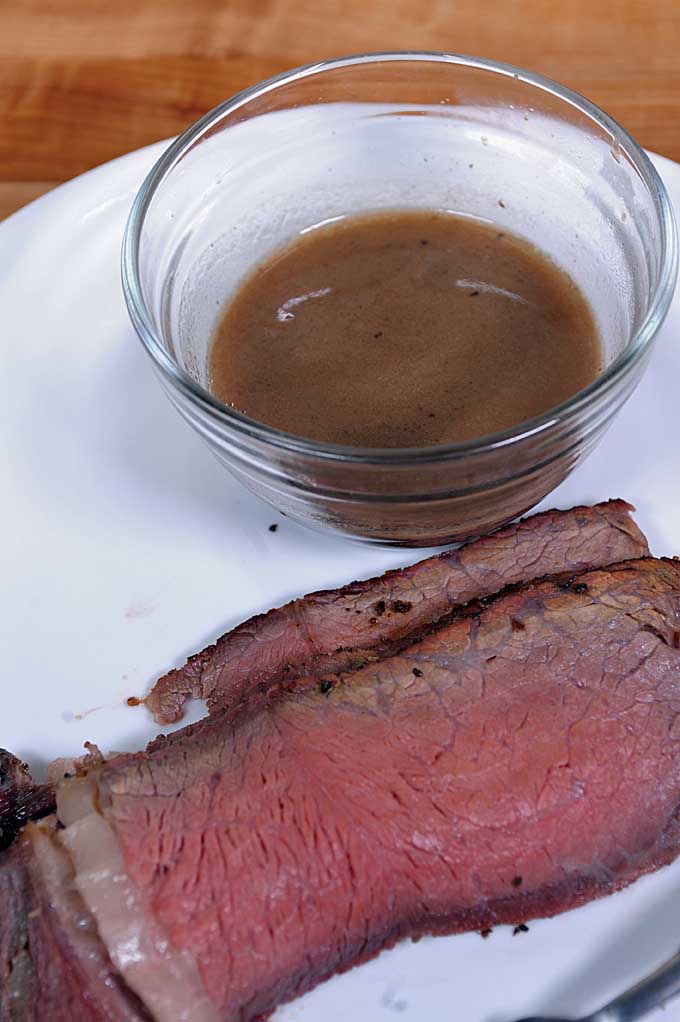
Although traditionally served with rib roasts or prime rib, brisket, roast beef, and other thicker cuts of beef, you can also adapt this recipe for other meats such as chicken, lamb, or turkey by replacing the beef stock with the matching stock. For example, to create a sauce to pair with a roast chicken, use chicken stock.
Note that it’s better to use homemade stock, but store bought is perfectly fine if you choose the low or no sodium varieties and select the product in the cartons rather than the cans. I find the canned variety to have a metallic aftertaste.
Also note that although I’m providing a recipe, some of this may partially be based on guesswork on your part with the final amount of au jus depending on the cut, portions, and number of people being served.
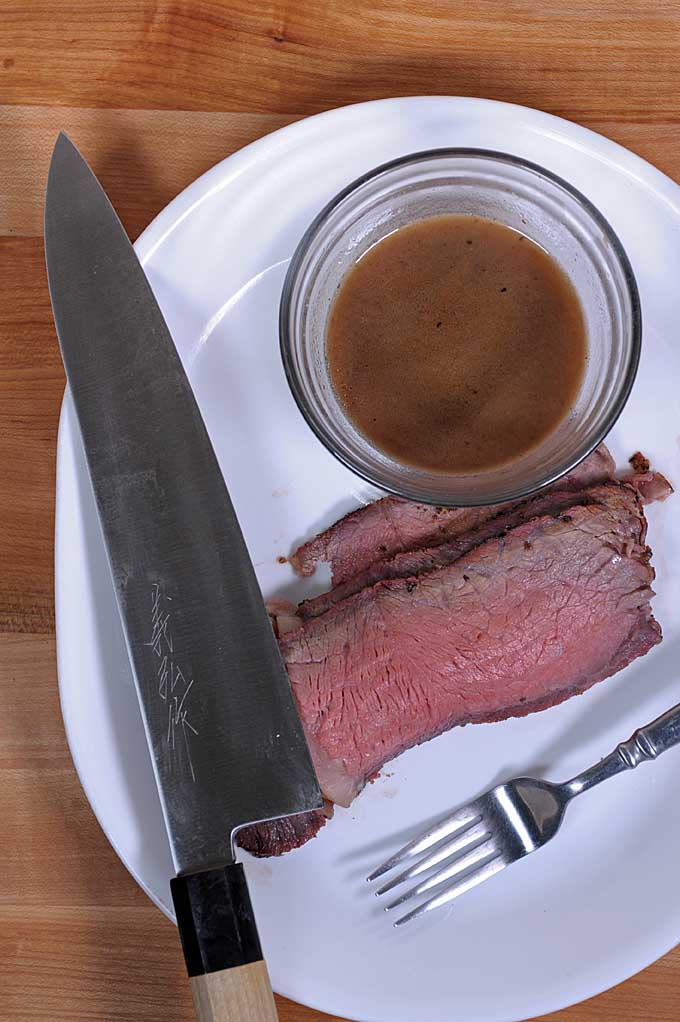
This recipe also includes dry red wine. You can use the cooking variety, but why? Have you ever tasted the stuff? It’s like a dry version of Mad Dog 20/20.
Do yourself a favor. Purchase two bottles – one white and one red – of inexpensive “real” wine to keep in your refrigerator to cook with. But just be prepared to lop the hands off of any teenagers in the household who may be inclined to sneak a drink or two.
The Recipe
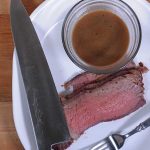
| Servings | Prep Time |
| 8 servings | 5 minutes |
| Cook Time |
| 60 minutes |
|
|

|
There's nothing that goes with a good prime rib or many other cuts of beef like a traditional au jus sauce. But how do you make it? Let Foodal show you how now, with our stepy-by-step instructions.
|
- 1 tablespoon Oil
- beef scraps and bones (optional)
- beef drippings from roasted meat (optional)
- 8 cups low sodium beef stock (2 32-ounce cartons)
- 1 cup dry red wine (semi-dry also works)
- 2 carrots coarsely chopped
- 1 onion divided into 8ths
- 1/4 teaspoon Freshly ground black pepper
- salt to taste
- Add oil to a 6 or 8-quart heavy duty stock pot (thick bottomed) and brown the meat scraps and bones over medium high heat. This is optional but it creates a bit of fond that adds to the flavor.
- Add the remaining ingredients minus the black pepper and salt (and the beef drippings if the roast is not ready). Bring to a boil, cover, and reduce to a high simmer for 30 minutes.
- Uncover the pot and add the black pepper if desired. Bring to boil and allow the liquid to reduce to about 1/3 of the original quantity.
- Remove from heat and scoop out the bones, beef scraps, and vegetables with a slotted spoon. Add the beef drippings prior to serving.
For a less cloudy sauce, you can stick the pan in the refrigerator or freezer for a few minutes and allow the fat to rise to the surface and harden. Simply skim it off the top. This is not recommended, as it does adversely impact the rich flavor.
Nutritional Information*
Cooking by the Numbers…
Step 1 – Prepare the Mise En Place
Chop your carrots and onions and lay our your beef bones and scraps, red wine, and cartons of beef broth (note only one carton is shown below, but the recipe requires two, unless you are just serving a few people). You can also use an equal amount of our homemade beef bone broth.
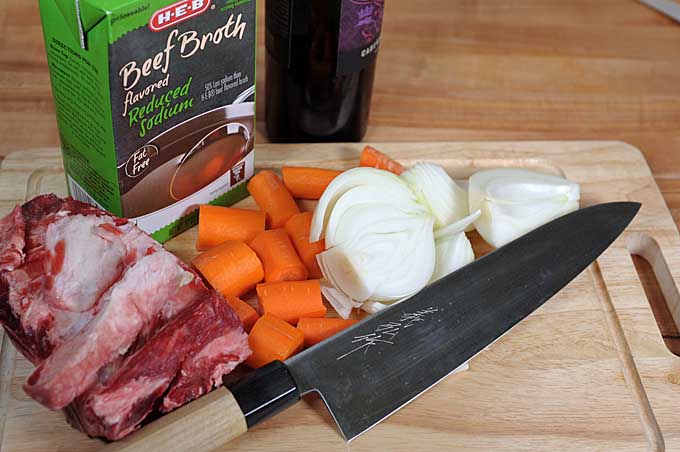
I like to add just a touch of black pepper as well, but I prefer to freshly grind mine and add it as the mixture is boiling.
Where to get beef bones? You can purchase them as soup bones from most butchers, but if I’m preparing a prime rib roast, I prefer to purchase as a “bone in” portion and cut the ribs away myself and “roll it” so that it cooks more evenly.
Step 2 – Brown the Meat Scraps (Optional)
This isn’t really required, but I like to brown my meat scraps and any meat surrounding the bone to create a more flavorful sauce. Place a bit of oil in a thick bottomed or tri-ply stock pot and turn the heat up to medium-high. Add the beef scraps and allow to brown.
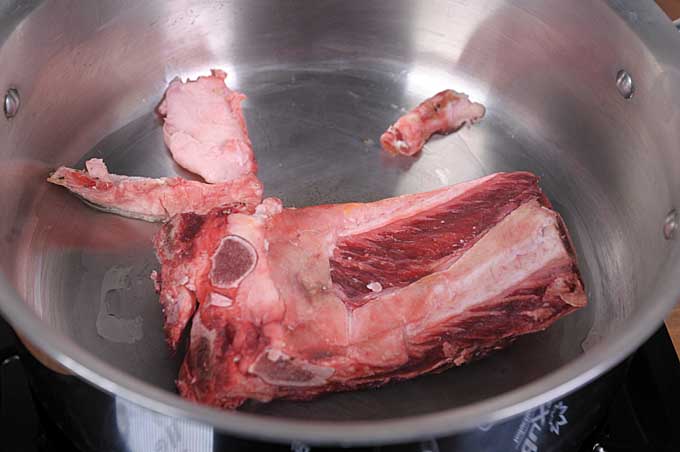
Don’t worry about the fond (the juice from the meat) sticking the pot. The wine and beef stock will deglaze it just fine.
Step 3 – Add the Ingredients and Simmer
Add the wine, beef stock, onions, and chopped carrots and bring to a boil. Reduce to a high simmer and allow to cook covered for 30 minutes. You can increase the cook time if you want to try to extract more flavor out of the bones and marrow.
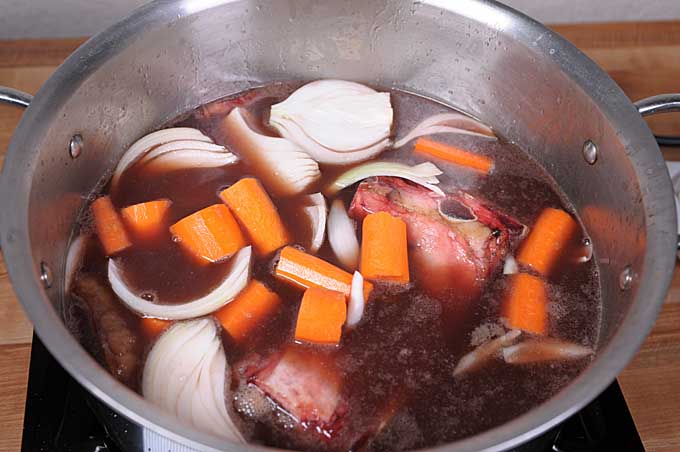
Step 4 – Boil and Reduce
Uncover and season with freshly ground black pepper if desired. Bring back to a boil and allow the mixture to reduce uncovered until you have about 1/3 of the liquid left; this usually takes 20 to 30 minutes, and occurs faster if you have a wider stock pot as it allows more room for steam to evaporate.
The whole point of this is to concentrate all of that beefy flavor from the stock and the added beef bits and bones.
Taste for salt and add some if required. If you started out with low sodium beef stock from a carton, the salt level should be “just right” at this point. If it is too salty, don’t be afraid to add a little water back in.
Step 5 – Remove the Bones, Carrots, and Onions
After the reduction is completed, remove the bones, scraps, carrots, and onions.
Sidenote: sometimes it is best to make this a day or two prior to when you plan to serve it, as these “scraps” can turn into a dandy little lunch for the cook.
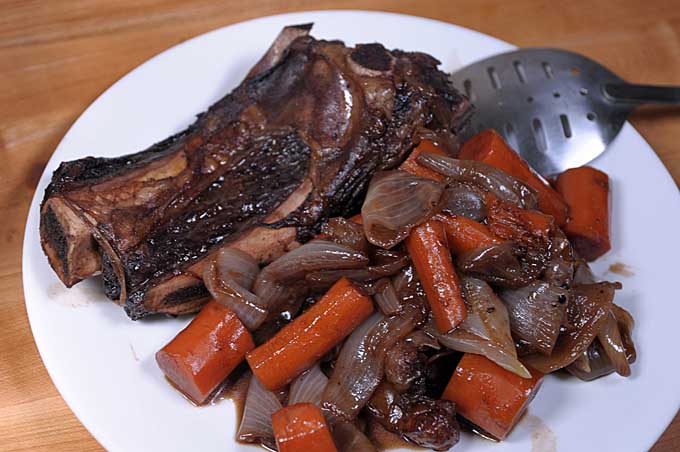
Now you are left with your completed au jus. If you want it to be a bit clearer, you can stick in the freezer for bit and allow the beef fat to harden on the surface, then remove it.
But why? Fat equals flavor. I’ll take a little cloudiness for additional taste any day of the week.
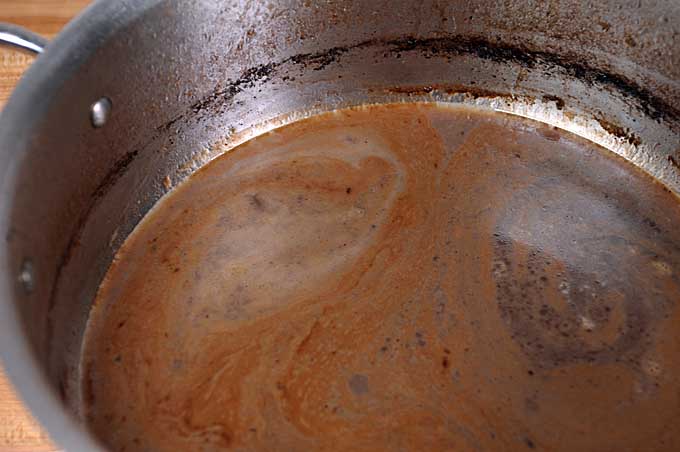
One final optional step: you can add any drippings that you may have collected in the preparation of your main course to the au jus. As you can see in the photo below, I’m collecting the juice from a standing rib roast that is being smoked.
Simply place a bowl under the meat. This technique also works in the oven.
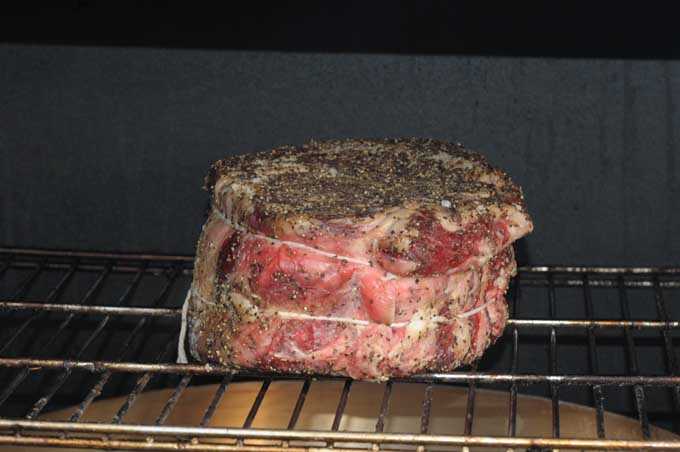
Some recipes call for adding flour, cornstarch, or other thickeners. That’s heretical in my book. Au jus is supposed to be thin. Crusty-french-bread-mopping-up-juices thin. Please don’t ruin it with thickeners!
Serve over a standing rib roast, roast beef, or a nice flaky beef wellington. You can also use it as a dipping sauce when serving roast beef sliders for a fun party.
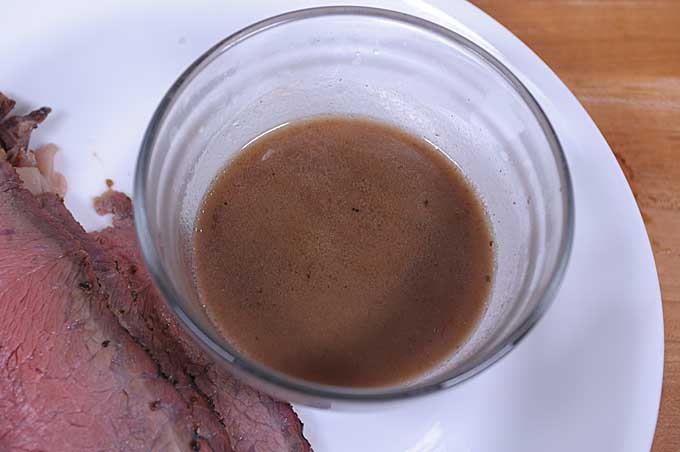
What about you? Do you have any au jus related tips of your own?
Be sure to let us know in the comments below, and before you go, please check out more of our protein tips, tricks, and guides.
Don’t forget to Pin It!
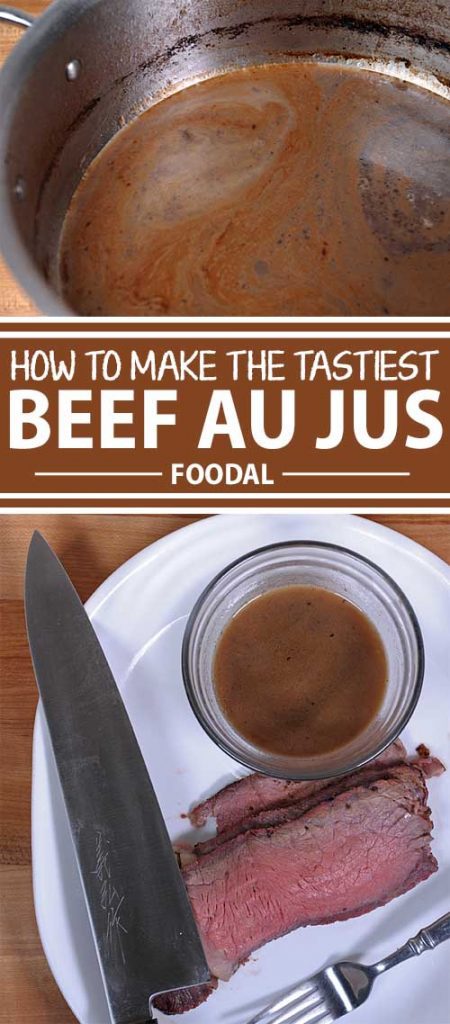
Photos by Mike Quinn, © Foodal / Ask the Experts, LLC. ALL RIGHTS RESERVED. See our TOS for more details.
*Nutritional information derived from a database of known generic and branded foods and ingredients and was not compiled by a registered dietitian or submitted for lab testing. It should be viewed as an approximation.
About Mike Quinn
Mike Quinn spent 20 years in the US Army and traveled extensively all over the world. As part of his military service, Mike sampled coffee and tea from all virtually every geographic region, from the beans from the plantation of an El Salvadorian Army Colonel to "Chi" in Iraq to Turkish Coffee in the Turkish Embassy in Kabul, Afghanistan. He spent nearly a decade in the Republic of Korea where he was exposed to all forms of traditional teas. Mike formerly owned and operated Cup And Brew, an online espresso and coffee equipment retail operation.

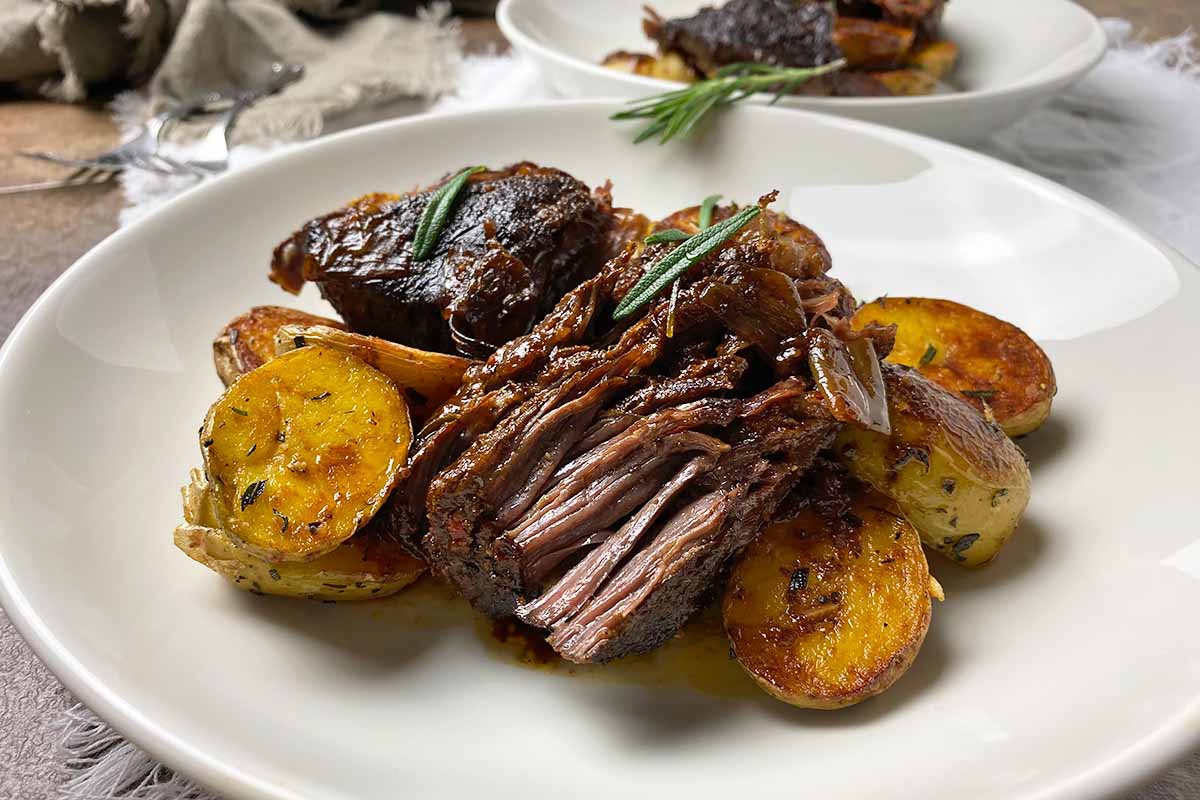
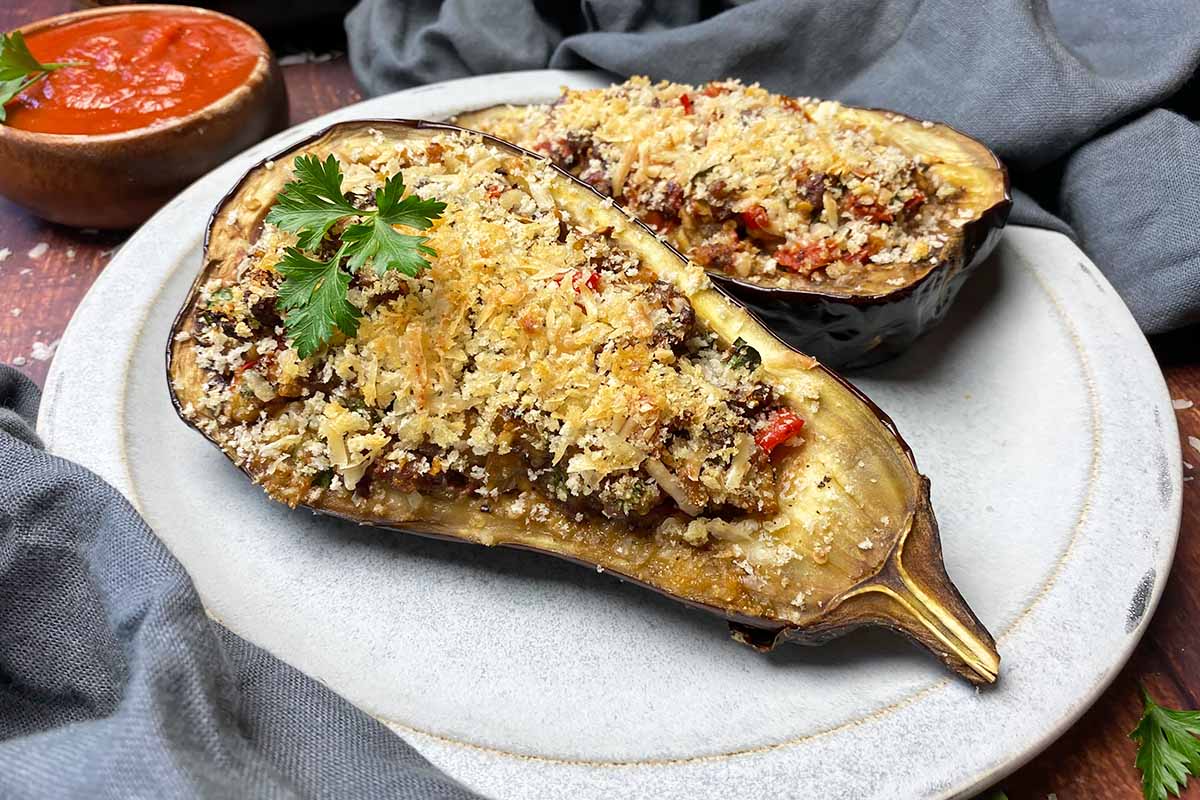
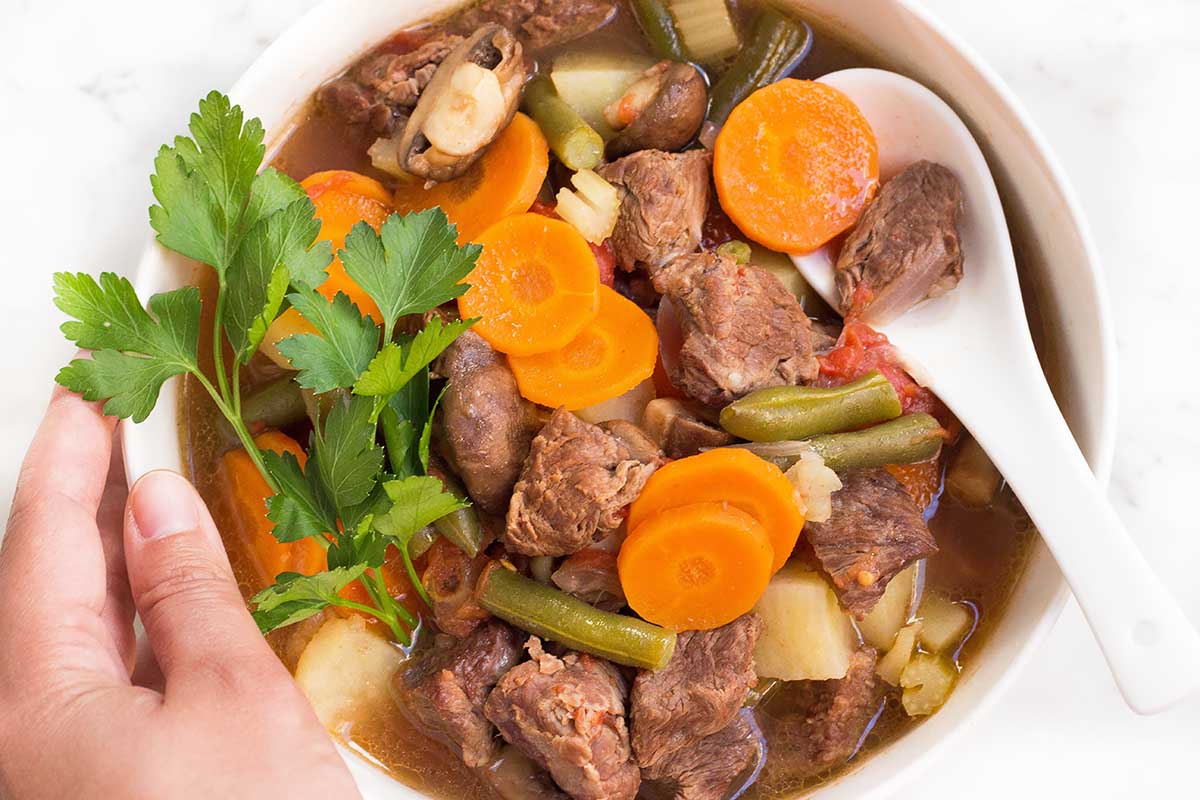
It is not pronounced “oh zhoo,” – my god where did you get educated?????
Stop spreading your ignorance and learn to pronounce it properly. It is a French word so say it properly – You americans! (sic)
Would you prefer “ō-ˈzhü(s),” as stipulated by Merriam-Webster’s Dictionary? We prefer to simplify, without diacritical marks. 🙂
Hope you have a lovely day, Jack!
Oh yeah? Your mother was a hamster and your father smelt of elderberries!
LOL
Great recipe Mike, much appreciated!
Oh my, just like we Texans who are known for our bragging (not a good trait), your post is like a snobby Frenchman. We don’t have to prove we are superior. Chill out Dude.
What an ass he’s just trying to help us and if you don’t like Americans get the hell out!!!!
The most ridiculous things get posted in comments- none about the flavor/quality which is what I was looking for. Come on people!
Why not just comment on the recipe? What is everyone commenting 12? Didn’t have beef stock so made my own with the bones and scraps from 2 roasts. Because of the fat I boiled I did scape off extra fat( but not all). Paired It with leftover prime rib cheesesteak. Fabulous! And easier than others. Thanks!
it says make a bold statement…so Jack Sprat did just that.